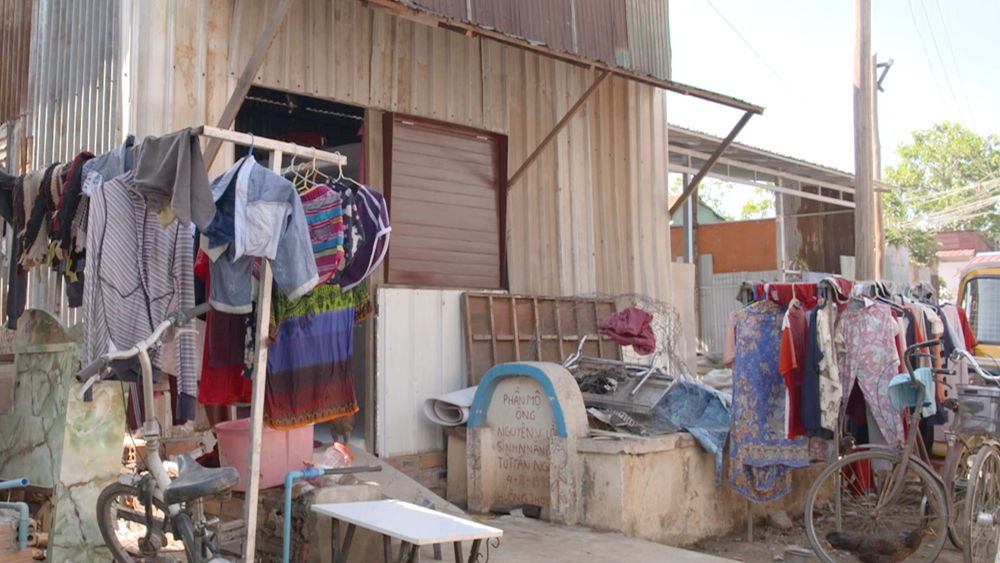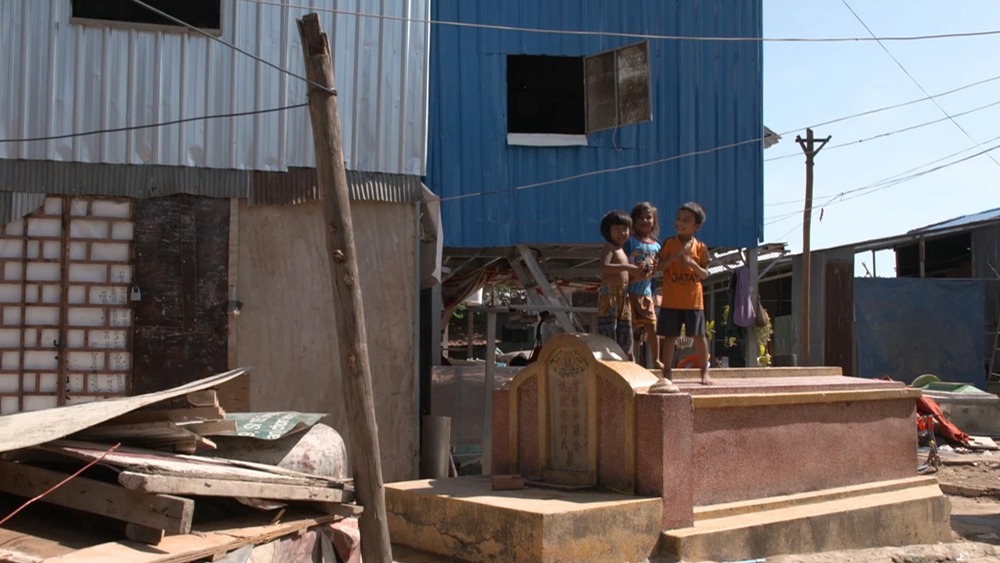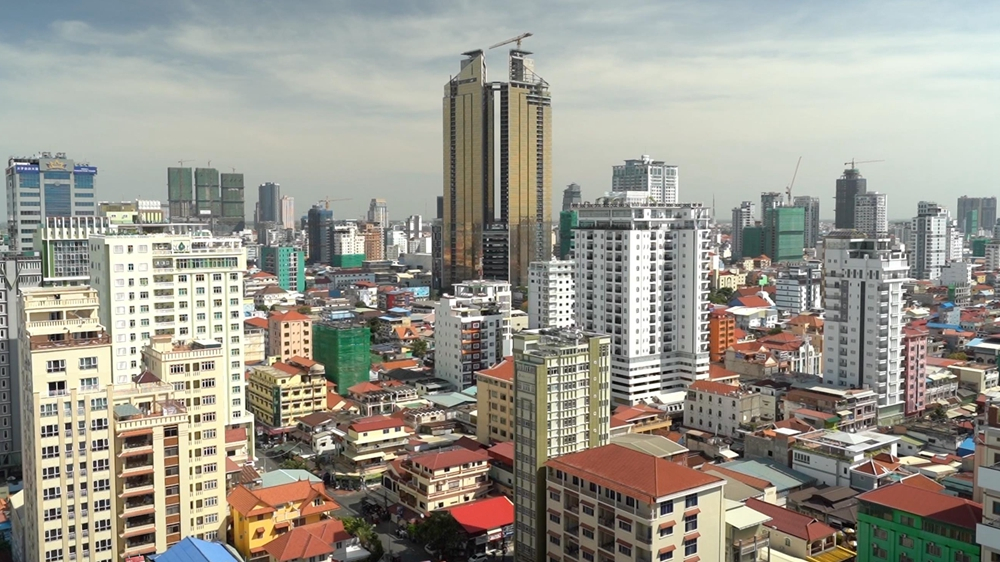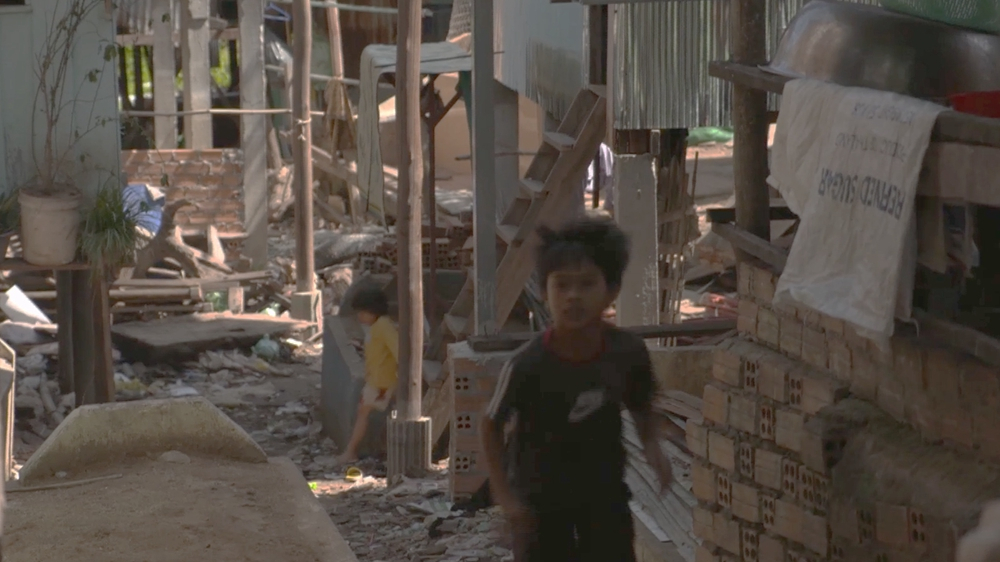
The graveyard in Thmor San, Phnom Penh, where almost 500 residents live surrounded by graves and tombs. /CGTN Photo
The graveyard in Thmor San, Phnom Penh, where almost 500 residents live surrounded by graves and tombs. /CGTN Photo
In a battered cemetery in Cambodia's capital city, Phnom Penh, the living outnumbers the dead. They have constructed makeshift houses on top of tombs and coffins, or inhabited vacant burial chambers, and it is here they eat dinner, watch TV, hang clothes to dry, care for their kids, and sleep – just inches away from the dead.
Like the other 500 or so residents that live amongst the graves, sand dredging led to the collapse of their riverbank houses, forcing many to move to this ghostly new home.
"I moved here because my house collapsed into the river," says Samnang, "I don't have anywhere else to live so that is why I live here."
This has been his home for almost 20 years. He shares it with his three children. In a tiny wooden shack, they all sleep on the floor. The cooking and washing areas are rolled into one. And the toilet they share with their neighbors is far from sanitary.

Many children in this community are unable to attend school. Some kids go hungry everyday, others risk abuse or have to work with adults instead of attending school. /CGTN Photo
Many children in this community are unable to attend school. Some kids go hungry everyday, others risk abuse or have to work with adults instead of attending school. /CGTN Photo
The 200 or so tombstones serve as a playground for the children, who clamber over them. It's a breeding ground for disease and abuse. The kids run barefoot through the cemetery while their parents scrape a living at the very bottom of Phnom Penh's economic hierarchy.
"It's tough because we don't have enough money to survive. It's difficult when it rains, the rain comes through the roof," Samnang says, "We have to sit when it rains and can only sleep when the rain stops."
Samnang used to work as a construction worker for eight U.S. dollars a day. The labor intensive worked resulted in a back injury. Now, one year later, with no source of income, he cannot support his family. Living in this cemetery is their only option.
Building their shacks out of materials they can find – tarps, sheets of corrugated tin or iron, election placards, scraps of plywood, whatever they can get their hands on – the residents cobble together lives from the things the rest of the city throws away.

According to CBRE Group, a global real estate and investment firm, "About 6,400 new construction projects totaling more than 12 billion U.S. dollars were approved in 2017 and 2018" in Cambodia. /CGTN Photo
According to CBRE Group, a global real estate and investment firm, "About 6,400 new construction projects totaling more than 12 billion U.S. dollars were approved in 2017 and 2018" in Cambodia. /CGTN Photo
This cemetery, south of Phnom Penh, lies along the banks of the Tonle Sap River, which divides the city. It's also a divide that couldn't be more obvious. Across the river is evidence of Phnom Penh's inequality. The charge of 'progress' means that much of Phnom Penh is hurtling skyward.
Cambodia's economy grew by 7.5 percent last year, a four-year high, making it one of the fastest growing economies in Southeast Asia. The capital resembles a massive building site with its construction sector attracting an increase of more than 50 percent over the same period last year.
While the city has experienced significant economic growth in recent years, rising housing prices, evictions and persisting poverty mean that many of its residents have not reaped the benefits.
Over the years, the capital's slums have been emptied – sometimes by evictions – scattering the urban poor in larger settlements on the city's fringes, where sanitation, electricity, jobs, schools and healthcare are harder to come by.

According to NGOs, this community faces many challenges: low incomes and high unemployment, high rates of alcohol and drug abuse and HIV/Aids, as well as malnutrition, domestic violence, child abuse and child labor. /CGTN Photo
According to NGOs, this community faces many challenges: low incomes and high unemployment, high rates of alcohol and drug abuse and HIV/Aids, as well as malnutrition, domestic violence, child abuse and child labor. /CGTN Photo
The cemetery has become a safe haven for many families seeking refuge from the streets. Many grew up in the cemetery, arriving there as toddlers, and are raising their own children and grandchildren there, with no sign of leaving any time soon.
"I don't feel scared living here," Samnang says, "but I do feel that it is disrespectful. When the family comes to visit the grave, I always stay at my neighbor's home because I feel bad that their relative's tomb is inside my home."
For Samnang and the other residents, everyday is a fight for survival. HIV/Aids, disease and abuse are rampant, and money and jobs scarce. But amidst all of this, the normal business of a cemetery goes on. Relatives still visit the graves of their loved ones knowing full well that this was not exactly the "rest in peace" they had imagined.